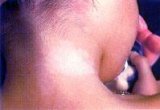
Fig.11 Vitiligo Pre Treatment

Fig.12 Segmental Vitiligo
Fig.11 Vitiligo Pre Treatment
In type A, the vitiligo present as multiple white patches which are generalized and symmetrical. The limbs, face and neck are the areas most commonly involved (Fig. 11).
Fig.12 Segmental Vitiligo
In type B, the vitiligo presents as localized patches in a segmental distribution. This type is common in children (Fig. 12).
Type A vitiligo tends to continue to spread with new lesions appearing over years whereas Type B vitiligo tends to spread rapidly then stops after about one year. The cause of vitiligo is not entirely known. Some people with vitiligo have a higher incidence of associated diabetes mellitus and thyroid disease.